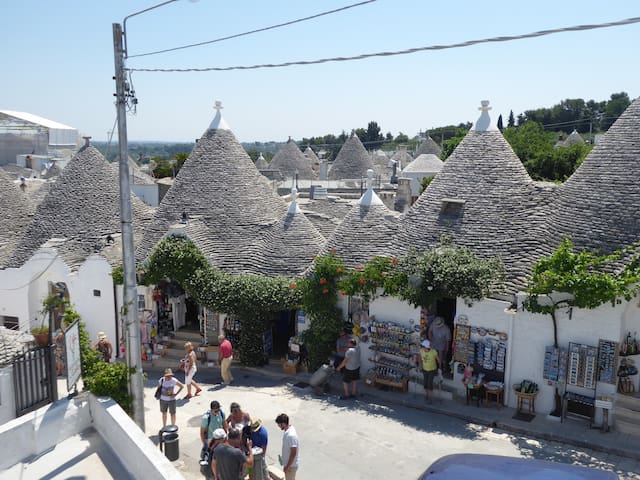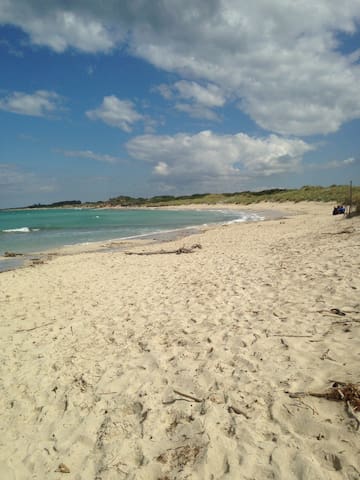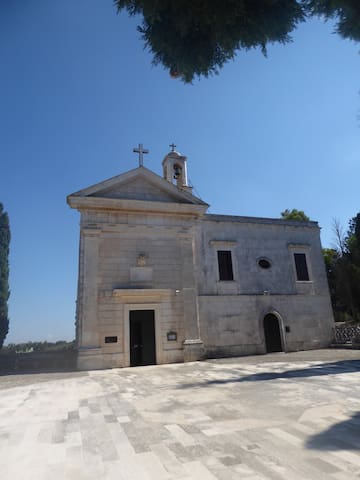Sightseeing
Ostuni - the White City - shines like a pearly white tiara, extending across three hills with the gem of a cathedral at its sparkling centrepiece. The maze of well-preserved winding streets provides a fascinating amble and there are some exceptional views.
886 helybéli ajánlásával
Ostuni
Ostuni - the White City - shines like a pearly white tiara, extending across three hills with the gem of a cathedral at its sparkling centrepiece. The maze of well-preserved winding streets provides a fascinating amble and there are some exceptional views.
About 1500 trulli houses pack the narrow streets. Alberobello is a World Heritage site.
963 helybéli ajánlásával
Alberobello
About 1500 trulli houses pack the narrow streets. Alberobello is a World Heritage site.
Historic Lecce is a beautiful Baroque town; it’s a glorious architectural confection of palaces and churches intricately sculpted from the local soft sandstone. It is a city full of surprises; one minute you are perusing sleek designer fashions from Milan, the next you are faced with a church – dizzyingly decorated with asparagus column tops, decorative dodos and cavorting gremlins.
91 helybéli ajánlásával
Province of Lecce
Historic Lecce is a beautiful Baroque town; it’s a glorious architectural confection of palaces and churches intricately sculpted from the local soft sandstone. It is a city full of surprises; one minute you are perusing sleek designer fashions from Milan, the next you are faced with a church – dizzyingly decorated with asparagus column tops, decorative dodos and cavorting gremlins.
Torre Guaceto - this is a WWF Natural Reserve; its name comes from the Arab Gawsit meaning “land of fresh water”. Since 1975 it has been declared a wetland of international interest and in 1991 a protected marine area has also been constituted. The reserve covers an area of nearly 22 km2 and 8 Km of coastline spread around the ancient fortified tower and is one of the best-preserved stretches of coast along the Adriatic coast.
The nature reserve is a protected area between the coast of Ostuni and that of Brindisi, at Serranova. It is a natural reserve of particular beauty and importance. The area is characterized by the presence of fresh water, which helped the growth of extensive woodlands and varied species of animals. Inside there are several habitats and landscapes, including a marine reserve with rocky and sandy seabeds; a wet and marshy area inhabited by amphibians and birds; sand dunes and long sandy beaches. The wetlands, fed by brackish water ponds, are an important feature of this reserve. Along the coast lie sandy dunes formed by the action of the wind.
The place is called after a tower, part of a series of towers existing along the coast. These were built in the 16th Century as a defence system by the Aragonese family. The natural area is divided into three zones that correspond to different types of protection and specific natural features. The most important area, Zone A, has a full protection status. Here hiking is possible but only with previous permission. The other 2 zones have a partial protection status
220 helybéli ajánlásával
Torre Guaceto
Torre Guaceto - this is a WWF Natural Reserve; its name comes from the Arab Gawsit meaning “land of fresh water”. Since 1975 it has been declared a wetland of international interest and in 1991 a protected marine area has also been constituted. The reserve covers an area of nearly 22 km2 and 8 Km of coastline spread around the ancient fortified tower and is one of the best-preserved stretches of coast along the Adriatic coast.
The nature reserve is a protected area between the coast of Ostuni and that of Brindisi, at Serranova. It is a natural reserve of particular beauty and importance. The area is characterized by the presence of fresh water, which helped the growth of extensive woodlands and varied species of animals. Inside there are several habitats and landscapes, including a marine reserve with rocky and sandy seabeds; a wet and marshy area inhabited by amphibians and birds; sand dunes and long sandy beaches. The wetlands, fed by brackish water ponds, are an important feature of this reserve. Along the coast lie sandy dunes formed by the action of the wind.
The place is called after a tower, part of a series of towers existing along the coast. These were built in the 16th Century as a defence system by the Aragonese family. The natural area is divided into three zones that correspond to different types of protection and specific natural features. The most important area, Zone A, has a full protection status. Here hiking is possible but only with previous permission. The other 2 zones have a partial protection status
Dip into this spectacularly positioned small town if you can. Located around 34km south of Bari on the S16 coastal road, Polignano a Mare is built on the edge of a craggy ravine pockmarked with caves. The town is thought to be one of the most important ancient settlements in Puglia and was later inhabited by successive invaders ranging from the Huns to the Normans. On Sunday the logge(balconies) are crowded with day trippers from Bari who come here to view the crashing waves, visit the caves and crowd out the cornetterias (shops specialising in Italian croissants) in the atmospheric centro storico.
701 helybéli ajánlásával
Polignano a Mare
Dip into this spectacularly positioned small town if you can. Located around 34km south of Bari on the S16 coastal road, Polignano a Mare is built on the edge of a craggy ravine pockmarked with caves. The town is thought to be one of the most important ancient settlements in Puglia and was later inhabited by successive invaders ranging from the Huns to the Normans. On Sunday the logge(balconies) are crowded with day trippers from Bari who come here to view the crashing waves, visit the caves and crowd out the cornetterias (shops specialising in Italian croissants) in the atmospheric centro storico.
A name that flows from the lips in the most wonderful of ways, and a delightful place truly deserving of the accolade 'Borghi più belli d'Italia' (one of the most beautiful villages in Italy).
Locorotondo – is a town and commune of the Metropolitan City of Bari, with a population of about 14,000. The city is known for its wines and for its circular structure, which is now a historical centre, from which it derives its name – which means ‘round place’.
One of the most fabulous thing about Locorotondo is the lack of determinable tourist attractions. This is a town to simply get lost in for a few hours. To leave the new town and enter the old, to wander tiny streets, to sit in the sun and sink a couple of aperol spritz, perhaps peruse one of the of many beautiful ateliers or dine fuori at one of the impossibly cute side-streets restaurants , but mostly, to just enjoy. Locorotondo is endowed with a whisper-quiet pedestrianised centro storico, where everything is shimmering white aside from the blood-red geraniums that tumble from the window boxes. The streets are paved with smooth ivory-coloured stones, with the church of Santa Maria della Graecia as their sun-baked centrepiece.
Being perched atop a big hill, Locorotondo is a fantastic place from which to survey the spectacular countryside around. Whilst views can be garnered from many spots in the city, for the very best vistas head to the limit of this hill-top town (easy to find in the small centro storico) and the small street that encircles its highest point, offering spectacular panoramic views.
353 helybéli ajánlásával
Locorotondo
A name that flows from the lips in the most wonderful of ways, and a delightful place truly deserving of the accolade 'Borghi più belli d'Italia' (one of the most beautiful villages in Italy).
Locorotondo – is a town and commune of the Metropolitan City of Bari, with a population of about 14,000. The city is known for its wines and for its circular structure, which is now a historical centre, from which it derives its name – which means ‘round place’.
One of the most fabulous thing about Locorotondo is the lack of determinable tourist attractions. This is a town to simply get lost in for a few hours. To leave the new town and enter the old, to wander tiny streets, to sit in the sun and sink a couple of aperol spritz, perhaps peruse one of the of many beautiful ateliers or dine fuori at one of the impossibly cute side-streets restaurants , but mostly, to just enjoy. Locorotondo is endowed with a whisper-quiet pedestrianised centro storico, where everything is shimmering white aside from the blood-red geraniums that tumble from the window boxes. The streets are paved with smooth ivory-coloured stones, with the church of Santa Maria della Graecia as their sun-baked centrepiece.
Being perched atop a big hill, Locorotondo is a fantastic place from which to survey the spectacular countryside around. Whilst views can be garnered from many spots in the city, for the very best vistas head to the limit of this hill-top town (easy to find in the small centro storico) and the small street that encircles its highest point, offering spectacular panoramic views.
Carovigno's charm comes mainly from the Middle Ages when the sinewy narrow lanes, palazzi and castle were built. The Castello Orsini-Balzi defended the town against the Turks when it was a feudal estate. The walls were extended and the massive fortress on the highest point to oversee the territory. It passed through several feudal families before becoming the seat of the Dentice de Frasso, the last lords, and the name that has remained on the castle since. It's an impressive structure with three towers, imposing walls and a chapel dedicated to St. Anna. The access is through the wholly charming Porta Ostuni archway.
50 helybéli ajánlásával
Carovigno
Carovigno's charm comes mainly from the Middle Ages when the sinewy narrow lanes, palazzi and castle were built. The Castello Orsini-Balzi defended the town against the Turks when it was a feudal estate. The walls were extended and the massive fortress on the highest point to oversee the territory. It passed through several feudal families before becoming the seat of the Dentice de Frasso, the last lords, and the name that has remained on the castle since. It's an impressive structure with three towers, imposing walls and a chapel dedicated to St. Anna. The access is through the wholly charming Porta Ostuni archway.
An exploration of the lovely Valle d’Itria (trulli country!) would not be complete without a visit to Martina Franca, the largest town in the area. This town is the highest in the Murgia, and was founded in the 10th century by refugees fleeing the Arab invasion of Taranto. It only started to flourish in the 14th century when Philip of Anjou granted tax exemptions (franchigie, hence Franca); the town became so wealthy that a castle and defensive walls complete with 24 solid bastions were built.
414 helybéli ajánlásával
Martina Franca
An exploration of the lovely Valle d’Itria (trulli country!) would not be complete without a visit to Martina Franca, the largest town in the area. This town is the highest in the Murgia, and was founded in the 10th century by refugees fleeing the Arab invasion of Taranto. It only started to flourish in the 14th century when Philip of Anjou granted tax exemptions (franchigie, hence Franca); the town became so wealthy that a castle and defensive walls complete with 24 solid bastions were built.
The sanctuary of Maria Santissima di Belvedere is dedicated to the Madonna, with the title of "Belvedere". The sanctuary is located on a hill about 100 meters above sea level, in an area where the landscape stands out towards a plain of secular olive trees up to the sea, for which the name "Belvedere" appears. The sanctuary is located 4 km north-east from Carovigno. Inside the sanctuary, there are two caves, placed at two different levels. Both are connected inside the church by a large flight of steps, the "holy staircase", formed in all by 47 steps. On the two levels there are various frescoes that mainly depict the Madonna di Belvedere. The sanctuary is a pilgrimage destination at various times of the year, particularly in the week after Easter, when Carovigno is in the midst of the festivities in honor of Maria Santissima di Belvedere, with the traditional almost millennial rite of the 'Nzegna’, which takes place on Monday and Tuesday after Easter in the village and Saturday after Easter in the Belvedere Sanctuary.
The sanctuary was built on two floors of caves, found according to legend, by a shepherd and a lord of Conversano – the shepherd was looking for his calf and the lord saw the image of the Madonna di Belvedere in a dream days before. This legend, led the town of Carovigno, to a strong devotion to the Madonna di Belvedere, with various pilgrimages during certain times of the year
Santuario di Maria Santissima di Belvedere
The sanctuary of Maria Santissima di Belvedere is dedicated to the Madonna, with the title of "Belvedere". The sanctuary is located on a hill about 100 meters above sea level, in an area where the landscape stands out towards a plain of secular olive trees up to the sea, for which the name "Belvedere" appears. The sanctuary is located 4 km north-east from Carovigno. Inside the sanctuary, there are two caves, placed at two different levels. Both are connected inside the church by a large flight of steps, the "holy staircase", formed in all by 47 steps. On the two levels there are various frescoes that mainly depict the Madonna di Belvedere. The sanctuary is a pilgrimage destination at various times of the year, particularly in the week after Easter, when Carovigno is in the midst of the festivities in honor of Maria Santissima di Belvedere, with the traditional almost millennial rite of the 'Nzegna’, which takes place on Monday and Tuesday after Easter in the village and Saturday after Easter in the Belvedere Sanctuary.
The sanctuary was built on two floors of caves, found according to legend, by a shepherd and a lord of Conversano – the shepherd was looking for his calf and the lord saw the image of the Madonna di Belvedere in a dream days before. This legend, led the town of Carovigno, to a strong devotion to the Madonna di Belvedere, with various pilgrimages during certain times of the year




